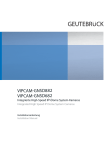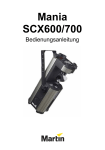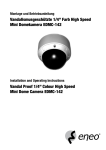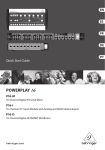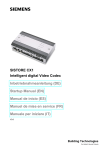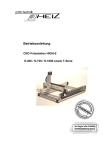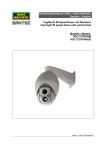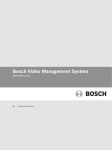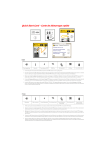Download Dome - Siemens Building Technologies
Transcript
SolarisTM Dome CCDS1425-ST CCDS1425-DN CCDS1425-DNX CCDS1425-DN36 Mounting instruction Montageanleitung Building Technologies Fire Safety & Security Products SolarisTM Dome CCDS1425-ST CCDS1425-DN CCDS1425-DNX CCDS1425-DN36 Mounting instruction Building Technologies Fire Safety & Security Products Liefermöglichkeiten und technische Änderungen vorbehalten. Data and design subject to change without notice. / Supply subject to availability. © 2008 Copyright by Siemens Building Technologies AG Wir behalten uns alle Rechte an diesem Dokument und an dem in ihm dargestellten Gegenstand vor. Der Empfänger erkennt diese Rechte an und wird dieses Dokument nicht ohne unsere vorgängige schriftliche Ermächtigung ganz oder teilweise Dritten zugänglich machen oder außerhalb des Zweckes verwenden, zu dem es ihm übergeben worden ist. We reserve all rights in this document and in the subject thereof. By acceptance of the document the recipient acknowledges these rights and undertakes not to publish the document nor the subject thereof in full or in part, nor to make them available to any third party without our prior express written authorization, nor to use it for any purpose other than for which it was delivered to him. Copyright Copyright 2008 © Fire & Security Products GmbH & Co. oHG. All rights reserved. Siemens Fire & Security Products GmbH & Co. oHG confers upon the purchaser the right to use the software. It is not permitted to reproduce this document in whole or in part or translate it into another language without our written consent. Trademarks SolarisTM is a trademark of Fire & Security Products GmbH & Co. oHG. Microsoft is a registered trademark and Windows a trademark of Microsoft Corporation. All other products or company names referred to explicitly in this manual are mentioned only for purposes of identification or description and may be trademarks or registered trademarks of their respective owners. Contacting us If you have questions or suggestions regarding the product or this documentation, please contact your local SIEMENS representative. Siemens Building Technologies Fire & Security Products GmbH & Co. oHG D-76181 Karlsruhe You can also visit our Web site at www.sbt.siemens.com. Training courses Siemens Fire Safety & Security Products provides training courses for all products. About this document This manual provides the information you will need in order to mount a Solaris™ Dome unit. NOTE For more detailed information please refer to the Configuration Manual on CD. Contents 1 1.1 1.2 1.2.1 1.2.2 1.3 1.4 Safety .......................................................................................................5 Target readers...........................................................................................5 General safety precautions .......................................................................5 Transport...................................................................................................5 Installation .................................................................................................5 Meaning of the signal words .....................................................................6 Meaning of the hazard symbols ................................................................6 2 EU Directive .............................................................................................6 3 3.1 3.2 3.3 3.4 3.5 3.5.1 3.5.2 Installation ...............................................................................................7 Tools required ...........................................................................................7 Installation procedure Solaris™ Dome .....................................................8 Cat5 cable assembly.................................................................................9 Connecting the Solaris™ Dome..............................................................15 Installation procedure External Termination Unit (XTU) .........................16 Choosing a location for the XTU .............................................................17 Mounting the XTU ...................................................................................17 4 Maintenance ..........................................................................................18 5 Disposal .................................................................................................18 3 Siemens Building Technologies Fire Safety & Security Products 10.2008 Safety 1 Safety 1.1 Target readers The instructions in this document are designed only for the following target readers: 1.2 Target readers Qualification Activity Condition of the product Installer Technical training for building or electrical installations. Installs the product, individual components of the product or replacement parts. Components of the product are not yet installed or need to be replaced or modified. General safety precautions z Read the general safety precautions before installing, configuring and operating the device. z Keep this document for reference. z Always pass this document on together with the product. z Please also take into account any additional country-specific, local safety standards or regulations concerning project planning, operation and disposal of the product. 1.2.1 Transport Damage during transport z Keep the packaging material for future transportation. z Do not expose the device to mechanical vibrations or shocks. 1.2.2 Installation z It is recommended that all preparatory work (e.g. fitting of accessories) be carried out in a workshop prior to final installation. Radio interference with other devices in the environment z When handling modules that are susceptible to electrostatic discharge, please observe the ESD guidelines. Damage due to unsuitable mounting location z The environmental conditions recommended by the manufacturer must be observed. See Configuration Manual. z Do not operate the device close to sources of powerful electromagnetic radiation. 5 Siemens Building Technologies Fire Safety & Security Products 10.2008 EU Directive Danger of electrical shock due to incorrect connection z Connect the device only to power sources with the specified voltage. Voltage supply requirements can be found on the mains adapter. z Make sure the device is permanently connected to the electricity supply; a readily accessible disconnect device must be provided. z This device is designed to work with TN power systems. Do not connect the device to any other power systems. 1.3 Meaning of the signal words The severity of a hazard is indicated by the following written signal words. 1.4 Signal word Type of risk CAUTION There is a risk of minor to medium injuries or damage to property. IMPORTANT Malfunctioning may result. Meaning of the hazard symbols The nature of the hazard is indicated by icons. Warning of a hazard 2 EU Directive The product complies with the requirements of the following EU directives. The EU declaration of conformity is available from: Siemens Building Technologies Fire & Security Products GmbH & Co. oHG 76181 Karlsruhe Germany European Directive 2004/108/EC “Electromagnetic Compatibility” Compliance with the European Directive 2004/108/EC has been proven by testing according to the following standards: Emitted interference: EN 61000-6-3 Resistance to interference: EN 50130-4 EN 55022 Class B European Directive 2006/95/EC “Low-Voltage Directive” Compliance with the European Directive 2006/95/EC has been proven by testing according to the following standard: Safety: EN 60950-1 6 Siemens Building Technologies Fire Safety & Security Products 10.2008 Installation 3 Installation Before commencing use of the Solaris™ system, ensure the following has been completed: 1. Ensure you have the correct tools to complete the installation, (see Section 3.1: Tools required). 2. Install the desired bracket in a suitable location. 3. Prepare the Dome bracket and attach it to the appropriate mounting bracket. 4. Assemble the Cat5 cable (see Section 3.3: Cat5 cable assembly). 5. Hook the Dome on to the hinge mechanism and connect the cable, clipping it in place (ensure that it is correctly and firmly seated on the connector). Pull the Dome into the vertical position (see Section 3.4 Connecting the Solaris™ Dome). 6. Check the bubble and ensure there are no scratches on the surface. If the surface is marked, it may impair optical clarity. 7. Select a suitable location and mount the XTU, (see Sections 3.5.1: Choosing a location for the XTU and 3.5.2: Mounting the XTU). 8. Connect the XTU to any external equipment. 9. If necessary, adjust the orientation of the XTU’s LCD display. 10. Configure the XTU to use the correct telemetry protocol and to identify itself correctly. 11. Setup the controller, (see the controller’s installation and commissioning manual). NOTE For more detailed information please refer to the Configuration Manual on CD. 3.1 Tools required Installing the Dome unit and the External Termination Unit requires only a basic tool kit, including: z 3 mm AF Allen key (supplied with ceiling mounting kit) z Medium-sized Pozidrive screwdriver (flat) z RJ-45 crimping tool (only if custom Dome to XTU cable is used) z Suitable tools for chosen fasteners for fitting bracketry and mounting the XTU z Suitable tools to install the required cabling and connections CAUTION Handle the bubble of the Solaris™ Dome with extreme care and be sure not to scratch it, as this may affect its optical clarity. If it is accidentally marked it may be possible to remove small scratches or scuffs on the outer surface with the use of a suitable cloth and metal polish (brass cleaner). However, if this is not effective the bubble must be replaced. 7 Siemens Building Technologies Fire Safety & Security Products 10.2008 Installation 3.2 Installation procedure Solaris™ Dome The two-piece mounting bracket and the hinge mechanism built into the Dome casing make the physical installation very simple. Making the electrical connections is just as simple. All of these are provided via a single connector fitted to the Cat-5 cable supplied. This just needs to be plugged in and clipped in place before the Dome casing is closed and fixed with a single screw. This combination ensures quick installation of the Dome. Installation using the recessed ceiling tile mount utilises a simplified fixing procedure compared to other Domes and the electrical connections are just as simple as with the bracket and pendant mounted units. Fig. 1 Cross-sectional view of the Solaris™ Dome To install the dome unit, proceed as follows: 1. First install the appropriate mounting bracket. 2. Prepare the Dome bracket. 3. Route the cable through the Dome bracket. See Section 3.3: Cat5 cable assembly. 4. Connect the cable to the Dome unit. See Section3.4 Connecting the Solaris™ Dome. 5. Attach the Dome to the Dome bracket. 8 Siemens Building Technologies Fire Safety & Security Products 10.2008 Installation 3.3 Cat5 cable assembly Solaris™ is supplied with a 15 m preassembled Cat 5 cable. In some cases, it may be necessary to change the cable (for a shorter cable or to replace a damaged cable, for example). It is very important that the cable assembly is assembled / disassembled in the following manner, to ensure a watertight seal between the connector and the Dome unit. IMPORTANT The Solaris™ Dome will not be fully water protected if these vital checks are not made prior to finalising the installation. 1 Label 2 Bayonet Style Connector 3 Receptacle 4 Seal 1 5 Seal 2 9 Siemens Building Technologies Fire Safety & Security Products 10.2008 Installation 1 Protective Sleeve 2 Connector Locking Nut 3 Connector Body 4 Cat 5 Cable Assembly 5 Conductors 6 Load Bar 7 RJ45 Plug 1. Ensure that the connector is assembled as per the overview above. Ensure that the locking nut is sufficiently tight to seal the assembly. Full assembly instructions can be found in the Installation Manual. 2. Ensure that Seal 1 is present and fitted correctly. 3. Ensure that Seal 2 is present and fitted correctly. 4. Remove the Label adhered to the Solaris™ connector. 5. Make the connection. 6. Ensure that the connector ‘bayonet style’ lockring securely fastens and locks the connector to the Solaris™ Dome. Î This will ensure that Solaris™ is waterproof. Assembly 1. Pass the protective sleeve over the cable end. 10 Siemens Building Technologies Fire Safety & Security Products 10.2008 Installation 2. Pass the connector locking nut over the cable end. 3. Pass the connector body over the cable end. 4. Carefully cut and strip the Cat 5 cable sheath to 25 mm. 5. Compress the end of the sheathed cable to flatten the conductors. Conductor pairs must be oriented side-by-side as shown in the Cat 5 cable wiring diagram (See Configuration Manual). The conductor tips must be trimmed evenly to 19 mm, maintaining conductor orientation. 6. The conductors (maintaining arrangement) must be inserted into the load bar (oriented so that the cable notch will align with the contacts – see detail in section 7 below) until the cable jacket rests against the cable notch. Conductor twist must not pass through the front of the load bar. 11 Siemens Building Technologies Fire Safety & Security Products 10.2008 Installation 7. The conductor twist must not enter the front of the load bar. The conductors must be trimmed evenly and square with the front edge of the load bar to 5 mm. 8. The conductors must be retracted from the load bar so that the conductors protrude from the end of the load bar to 1 mm (G). The top of the load bar must not be deformed. 12 Siemens Building Technologies Fire Safety & Security Products 10.2008 Installation 9. The load bar (oriented so that the larger cable notch is aligned with the contacts, as shown in section 6 above) must be inserted into the RJ-45 plug until it butts against the mating feature of the RJ-45 plug, and the conductors are bottomed on the wire circuits. – The cable jacket must be against the cable notch after the load bar is fully seated. – The conductors must not be exposed between the cable jacket and cable notch. – The ends of the conductors must be clearly visible through the front of the RJ- 45 plug. 10. The RJ-45 plug must be terminated to the cable according to the instructions included with the appropriate tooling. 1 Large cable notch in Load bar 2 RJ45 Plug contacts 11. To ensure that the cable assembly is sufficiently sealed: – The locking tab must be fully engaged with the wide slot at the front of the plug assembly. – The protective tubing must be visible exiting the rear of the connector. – The cable fitting must be tightened to 1.7 – 2.8 Nm. The cable must be restricted by the connector assembly; cable slide within the connector is not permitted. 13 Siemens Building Technologies Fire Safety & Security Products 10.2008 Installation 1 Cable fitting 2 Locking tab 12. Loop the cable as shown. Lock the cable in position with a cable tie. Secure the cable loop and cut off any excess cable tie. This ‘loop and tie’ will divert water that runs down the cable away from the connector assembly. Do not over-tighten the cable tie as this could cause damage to the Cat 5 cable. 14 Siemens Building Technologies Fire Safety & Security Products 10.2008 Installation 3.4 Connecting the Solaris™ Dome 1. Offer the Dome up to the mounting bracket and hook it on to the hinge mechanism. The hinge should now take the weight of the Dome, leaving your hand free to make the connection. 2. Remove the dust cap. It is held to the unit with a lanyard so it will not be misplaced. Position the dust cap loosely to the side of the bulkhead connector. 3. Feed the cable through the opening. 4. Ensure that the connection to the dome is water sealed by turning the ‘Bayonet-style” locking ring until it locks into position. 15 Siemens Building Technologies Fire Safety & Security Products 10.2008 Installation 5. Pull the Dome unit into the vertical position (taking care that the cable doesn’t snag) and lock it into place with the fixing screw. Î 3.5 The installation of the Dome is now complete. Installation procedure External Termination Unit (XTU) The XTU is very straightforward to install; these are the basic steps required: 1. Select a suitable location for the installation to allow the most suitable access to the required cabling (power, telemetry, alarms etc.) and the Dome. See Section 3.5.1: Choosing a location for the XTU. 2. Select the appropriate cable glands for the cabling/connections to be used and remove the required knockouts in the enclosure. 3. Mount the XTU in the selected position and orientation using appropriate fasteners for the mounting substrate. See Section 3.5.2: Mounting the XTU. 4. Set the RS485 termination resistor if required. 5. Route and connect all of the required cabling to the XTU (use the supplied special M20 split rubber cable gland for the Dome connection cable) 6. Power up the XTU. 7. Orientate the LCD display to suit the mounted position. 8. Set-up the XTU to operate correctly with your chosen controller, set the protocol (e.g. MOLYNX V3), set the interface (e.g. RS485 or Coax control), set the receiver address (e.g. camera '1'). 9. Optional video test. Press the key, the XTU LCD should display a digitised view of what the Dome camera is pointing at. Press the key to resume normal operation. 10. After the XTU has been fully set-up fit the lid on the XTU securely using the 4 lid mounting screws to ensure a weatherproof seal. 16 Siemens Building Technologies Fire Safety & Security Products 10.2008 Installation 3.5.1 Choosing a location for the XTU The XTU should be located in a position which allows the most suitable and convenient routing and connection of the required cabling. Factors to consider are the proximity to the Dome unit (15 m cable supplied as standard, extendable to *30 m maximum), power supply, connections to telemetry controller, alarms and the security/protection of the chosen location. The XTU is fitted with a tamper switch that is activated upon opening of the enclosure, but the enclosure itself is not tamper-proof. If a cable longer than 15 m is required, it can be increased to 30 m maximum, using Cat-5e UTP 4 pair 24 AWG type cable. Ensure the correct coloured wires are wired to the correct pins. 3.5.2 Mounting the XTU Once a suitable location has been found, mark the positions of the four mounting holes at 235 mm x 160 mm. The mounting holes in the enclosure have a diameter of 4.5 mm, so select fasteners to suit this and drill holes to match the chosen fasteners and mounting substrate. The head of the fasteners used should not exceed 9 mm in diameter. IMPORTANT To ensure that the unit is weatherproof (IP66) the cable glands must point downwards. Remove the required gland knockouts by punching through the plastic around the edge of the knockouts using a small screwdriver. Knockouts are available in the enclosure for the following metric cable glands: z 7 x M12/M20 z 2 x M16/M25 Offer the enclosure up to the mounting holes and fix in place with the chosen fasteners. 17 Siemens Building Technologies Fire Safety & Security Products 10.2008 Maintenance 4 Maintenance Defective modules should be sent to the nearest Siemens office to be forwarded to the service centre. 5 Disposal All electrical and electronic products should be disposed of separately from the municipal waste stream via designated collection facilities appointed by the government or the local authorities. This crossed-out wheeled bin symbol on the product means the product is covered by the European Directive 2002/96/EC. The correct disposal and separate collection of your old appliance will help prevent potential negative consequences for the environment and human health. It is a precondition for reuse and recycling of used electrical and electronic equipment. For more detailed information about disposal of your old appliance, please contact your city office, waste disposal service or the shop where you purchased the product. 18 Siemens Building Technologies Fire Safety & Security Products 10.2008 Issued by Siemens Building Technologies Fire & Security Products GmbH & Co. oHG D-76181 Karlsruhe www.buildingtechnologies.siemens.com Document no. A6V19226427 Edition 23.10.2008 © 2008 Copyright by Siemens Building Technologies AG Data and design subject to change without notice. Supply subject to availability. Printed in the Federal Republic of Germany on environment-friendly chlorine-free paper. SolarisTM Dome CCDS1425-ST CCDS1425-DN CCDS1425-DNX CCDS1425-DN36 Montageanleitung Building Technologies Fire Safety & Security Products Liefermöglichkeiten und technische Änderungen vorbehalten. Data and design subject to change without notice. / Supply subject to availability. © 2008 Copyright by Siemens Building Technologies AG Wir behalten uns alle Rechte an diesem Dokument und an dem in ihm dargestellten Gegenstand vor. Der Empfänger erkennt diese Rechte an und wird dieses Dokument nicht ohne unsere vorgängige schriftliche Ermächtigung ganz oder teilweise Dritten zugänglich machen oder außerhalb des Zweckes verwenden, zu dem es ihm übergeben worden ist. We reserve all rights in this document and in the subject thereof. By acceptance of the document the recipient acknowledges these rights and undertakes not to publish the document nor the subject thereof in full or in part, nor to make them available to any third party without our prior express written authorization, nor to use it for any purpose other than for which it was delivered to him. Copyright Copyright 2008 © Fire & Security Products GmbH & Co. oHG. Alle Rechte vorbehalten. Siemens Fire & Security Products GmbH & Co. oHG überträgt dem Käufer das Recht zur Benutzung der Software. Dieses Dokument darf ohne unsere schriftliche Einwilligung weder ganz noch teilweise reproduziert oder in eine andere Sprache übersetzt werden. Warenzeichen SolarisTM ist ein Warenzeichen der Fire & Security Products GmbH & Co. oHG. Microsoft ist ein eingetragenes Warenzeichen und Windows ein Warenzeichen der Microsoft Corporation. Alle anderen Produkte oder Unternehmen, auf die in diesem Handbuch ausdrücklich Bezug genommen wird, werden nur zum Zwecke der Bezeichnung und/oder Beschreibung erwähnt und sind unter Umständen Warenzeichen oder eingetragene Warenzeichen ihrer jeweiligen Eigentümer. Kontaktaufnahme Bei Fragen oder Vorschlägen in Bezug auf dieses Produkt oder diese Dokumentation wenden Sie sich bitte an Ihren zuständigen SIEMENS-Vertreter. Siemens Building Technologies Fire & Security Products GmbH & Co. oHG D-76181 Karlsruhe Oder Sie besuchen unsere Website unter www.sbt.siemens.com. Schulungen Siemens Fire Safety & Security Products bietet die für alle Produkte Schulungskurse an. Hinweise zu diesem Dokument Dieses Handbuch enthält alle erforderlichen Informationen für die Montage einer Solaris™ Dome-Einheit. HINWEIS Ausführliche Informationen finden Sie im Konfigurationshandbuch auf der CD. Inhalt 1 1.1 1.2 1.2.1 1.2.2 1.3 1.4 Sicherheit.................................................................................................5 Zielgruppe .................................................................................................5 Allgemeine Sicherheitshinweise ...............................................................5 Transport...................................................................................................5 Installation .................................................................................................5 Bedeutung der Signalwörter .....................................................................6 Bedeutung der Gefahrensymbole .............................................................6 2 EG-Richtlinien .........................................................................................6 3 3.1 3.2 3.3 3.4 3.5 3.5.1 3.5.2 Installation ...............................................................................................7 Erforderliche Werkzeuge ..........................................................................7 Installation des Solaris™-Dome................................................................8 Cat5-Kabel montieren ...............................................................................9 Solaris™-Dome anschließen ..................................................................15 Installation der externen Terminierungseinheit (XTU) ............................16 Auswahl eines Platzes für die XTU.........................................................17 Montage der XTU....................................................................................17 4 Wartung..................................................................................................18 5 Entsorgung ............................................................................................18 3 Siemens Building Technologies Fire Safety & Security Products 10.2008 Sicherheit 1 Sicherheit 1.1 Zielgruppe Die Anweisungen in diesem Dokument gelten nur für folgende Personen: 1.2 Zielgruppe Qualifikation Tätigkeit Zustand des Produkts Installateur Besitzt Fachkenntnisse im Bereich Gebäudeinstallationstechnik oder Elektroinstallationen. Installiert das Produkt, Einzelkomponenten oder Ersatzteile des Produkts. Einzelkomponenten des Produkts sind noch nicht installiert oder müssen ersetzt oder umgebaut werden.. Allgemeine Sicherheitshinweise z Lesen Sie vor der Installation, Konfiguration und Inbetriebnahme des Gerätes die allgemeinen Sicherheitshinweise. z Bewahren Sie dieses Dokument für zukünftige Zwecke auf. z Geben Sie dieses Dokument immer zusammen mit dem Produkt weiter. z Beachten Sie bitte alle zusätzlichen länderspezifischen Sicherheitsnormen oder -vorschriften hinsichtlich Projektplanung, Betrieb und Entsorgung des Produkts. 1.2.1 Transport Transportschäden z Bewahren Sie das Verpackungsmaterial für einen zukünftigen Transport auf. z Setzen Sie das Gerät keinen mechanischen Erschütterungen oder Stößen aus. 1.2.2 Installation z Wir empfehlen Ihnen, alle vorbereitenden Arbeiten (wie z. B. Installation von Zubehörteilen) an einem dafür vorgesehenen Ort (z. B. in einer Werkstatt) vor der Installation des Produkts auszuführen. Funkstörungen im Umfeld anderer Geräte z Beachten Sie beim Berühren von elektrostatisch gefährdeten Baugruppen und Bauteilen die Handhabungsvorschriften (EGB-Richtlinie). Schäden aufgrund eines ungeeigneten Montageortes z Beachten Sie die vom Hersteller empfohlenen Umgebungsbedingungen. Siehe Konfigurationshandbuch. z Betreiben Sie das Gerät nicht in der Nähe starker elektromagnetischer Strahlung. 5 Siemens Building Technologies Fire Safety & Security Products 10.2008 EG-Richtlinien Stromschlaggefahr durch falschen Anschluss z Schließen Sie das Gerät nur an Stromquellen mit der vorgeschriebenen Spannung an. Auf dem Netzteil finden Sie Hinweise zur Spannungsversorgung. z Betreiben Sie das Gerät nur mit Festanschluss und gut zugänglicher Trennvorrichtung am Versorgungskreis. z Dieses Gerät ist nur für TN- Stromversorgungsnetze ausgelegt. Schließen Sie das Gerät nicht an andere Stromversorgungsnetze an. 1.3 Bedeutung der Signalwörter Auf die Schwere der Gefahr wird mit Signalwörtern hingewiesen. Signalwort 1.4 Art der Gefahr VORSICHT Gefahr von mittlerer bzw. leichter Körperverletzung oder Sachschaden WICHTIG Gefahr von Funktionsstörungen Bedeutung der Gefahrensymbole Die Art der Gefahr wird durch Symbole angedeutet. Warnung vor einer Gefahr 2 EG-Richtlinien Das Produkt erfüllt die Anforderungen der nachfolgenden EG-Richtlinien. Die EUKonformitätserklärung ist erhältlich bei: Siemens Building Technologies Fire & Security Products GmbH & Co. oHG 76181 Karlsruhe Deutschland EG-Richtlinie 2004/108/EG “Elektromagnetische Verträglichkeit” Die Konformität mit der EG-Richtlinie 2004/108/EC wird nachgewiesen durch die Einhaltung folgender Normen: Störaussendung: EN 61000-6-3: Störsicherheit: EN 50130-4 EN 55022 Klasse B EG-Richtlinie 2006/95/EG “Niederspannungsrichtlinie” Die Konformität mit der EG-Richtlinie 2006/95/EC wird nachgewiesen durch die Einhaltung folgender Norm: Sicherheit: EN 60950-1 6 Siemens Building Technologies Fire Safety & Security Products 10.2008 Installation 3 Installation Bevor Sie das Solaris™-System benutzen, sollten Sie Folgendes sicherstellen: 1. Achten Sie darauf, die richtigen Werkzeuge zu haben, um die Installation durchführen zu können (siehe Abschnitt 3.1 Erforderliche Werkzeuge). 2. Bringen Sie die gewünschte Halterung an einer geeigneten Stelle an. 3. Bereiten Sie die Dome-Halterung vor und befestigen Sie sie an der entsprechenden Montagehalterung. 4. Montieren Sie das Cat5-Kabel (siehe Abschnitt 3.3 Cat5-Kabel montieren). 5. Haken Sie den Dome am Gelenkmechanismus ein und schließen Sie das Kabel an, indem Sie es einrasten lassen (achten Sie darauf, dass es korrekt angeschlossen ist und fest sitzt). Bringen Sie den Dome in die vertikale Position (siehe Abschnitt 3.4 Solaris™-Dome anschließen). 6. Überprüfen Sie die Kuppel und stellen Sie sicher, dass die Oberfläche keine Kratzer hat. Andernfalls kann es zu optischen Beeinträchtigungen kommen. 7. Wählen Sie einen geeigneten Platz und montieren Sie die XTU (siehe Abschnitte 3.5.1 Auswahl eines Platzes für die XTUund 3.5.2 Montage der XTU). 8. Schließen Sie die XTU an ein externes Gerät an. 9. Justieren Sie gegebenenfalls die Ausrichtung der LCD-Anzeige der XTU. 10. Konfigurieren Sie die XTU, damit sie das richtige Telemetrieprotokoll verwendet und sich korrekt identifiziert. 11. Konfigurieren Sie den Controller (siehe das Installations- und Inbetriebnahmehandbuch für den Controller). HINWEIS Ausführliche Informationen finden Sie im Konfigurationshandbuch auf der CD. 3.1 Erforderliche Werkzeuge Zum Installieren der Dome-Einheit und der externen Terminierungseinheit ist nur ein Basiswerkzeugsatz erforderlich, einschließlich: z 3-mm-Inbusschlüssel (im Lieferumfang des Deckenmontagesatzes) z mittelgroßer Pozidrive-Schraubendreher (flach) z RJ-45-Crimpzange (nur, wenn ein Dome-zu-XTU-Kabel verwendet wird) z geeignete Werkzeuge für die verwendeten Halterungen und zur Montage der XTU z geeignete Werkzeuge, um die erforderlichen Kabel zu installieren und die Anschlüsse vorzunehmen VORSICHT Handhaben Sie die Kuppel des Solaris™-Dome mit besonderer Vorsicht und achten Sie darauf, dass sie keine Kratzer bekommt, da dies die optische Klarheit beeinträchtigen könnte. Kleinere Kratzer oder Schrammen auf der Oberfläche lassen sich unter Umständen mit einem geeigneten Tuch und Metallpolitur (Messingreiniger) wieder entfernen. Sollte dies nicht funktionieren, muss die Kuppel ausgetauscht werden. 7 Siemens Building Technologies Fire Safety & Security Products 10.2008 Installation 3.2 Installation des Solaris™-Dome Die zweiteiligen Montagehalterung und der Gelenkmechanismus im DomeGehäuse machen die Installation sehr einfach. Genauso einfach ist das Herstellen der elektrischen Anschlüsse. Alle Anschlüsse erfolgen über einen einzelnen Stecker am mitgelieferten Cat-5-Kabel. Dieser muss nur angeschlossen und eingerastet werden, bevor das DomeGehäuse geschlossen und mit einer einzigen Schraube fixiert wird. Diese Kombination garantiert eine rasche Installation des Dome. Bei der Deckenmontage wird nach einem im Vergleich zu anderen Domes vereinfachten Verfahren vorgegangen; die elektrischen Anschlüsse lassen sich so einfach wie bei Einheiten mit Halterungs- und Abhängevorrichtung vornehmen. Fig. 1 Schnittzeichnung des Solaris™-Dome Um die Dome-Einheit zu installieren, gehen Sie wie folgt vor: 1. Bringen Sie zunächst die entsprechende Montagehalterung an. 2. Bereiten Sie die Dome-Halterung vor. 3. Führen Sie das Kabel durch die Dome-Halterung. Siehe Abschnitt 3.3 Cat5Kabel montieren. 4. Schließen Sie das Kabel an der Dome-Einheit an. Siehe Abschnitt 3.4 Solaris™-Dome anschließen. 5. Befestigen Sie den Dome an der Dome-Halterung. 8 Siemens Building Technologies Fire Safety & Security Products 10.2008 Installation 3.3 Cat5-Kabel montieren Zum Lieferumfang des Solaris™ gehört ein 15 m langes konfektioniertes Cat 5Kabel. In einigen Fällen kann es erforderlich sein, das Kabel zu ändern (z.B. um es zu kürzen oder ein beschädigtes Kabel zu ersetzen). Es ist äußerst wichtig, das Kabel auf folgende Weise zu montieren/demontieren, um eine wasserdichte Verbindung zwischen Stecker und Dome-Einheit sicherzustellen. WICHTIG 1 Etikett 2 Bajonettstecker 3 Steckerbuchse 4 Dichtung 1 5 Dichtung 2 Sollten vor dem Abschluss der Installation diese entscheidenden Prüfungen nicht vorgenommen werden, ist der Solaris™-Dome ist nicht vollständig wassergeschützt. 9 Siemens Building Technologies Fire Safety & Security Products 10.2008 Installation 1 Schutzhülse 2 Abschlussbuchse 3 Steckergehäuse 4 Cat 5-Kabeleinheit 5 Leiter 6 Führungsstück 7 RJ45-Stecker 1. Achten Sie darauf, den Stecker wie oben gezeigt zu montieren. Stellen Sie sicher, dass die Abschlussbuchse ausreichend fest sitzt, um die Montageeinheit abzudichten. Ausführliche Montageanweisungen finden Sie in der Installationsanleitung. 2. Achten Sie darauf, dass die Dichtung 1 vorhanden ist und richtig sitzt. 3. Achten Sie darauf, dass die Dichtung 2 vorhanden ist und richtig sitzt. 4. Entfernen Sie das am Solaris™-Anschluss angebrachte Etikett. 5. Nehmen Sie den Anschluss vor. 6. Achten Sie darauf, dass der Verschlussring des Bajonettsteckers richtig sitzt und den Stecker am Solaris™-Dome fixiert. Î Dadurch ist sichergestellt, dass der Solaris™-Dome wasserdicht ist. Montage 1. Ziehen Sie die Schutzhülse über das Kabelende. 10 Siemens Building Technologies Fire Safety & Security Products 10.2008 Installation 2. Schieben Sie die Abschlussbuchse über das Kabelende. 3. Schieben Sie den Stecker über das Kabelende. 4. Kürzen und isolieren Sie den Mantel des Cat 5-Kabels vorsichtig auf 25 mm ab. 5. Drücken Sie die das Ende des ummantelten Kabels zusammen, damit die Leiter nebeneinander zu liegen kommen. Die Leiterpaare müssen nebeneinander ausgerichtet sein wie im Anschlussplan für das Cat 5-Kabel dargestellt (siehe Konfigurationshandbuch). Kürzen Sie die Enden der Leiter gleichmäßig auf 19 mm; ihre Position darf dabei nicht verändert werden. 6. Schieben Sie die Leiter nun (ohne ihre Lage zu verändern) in das Führungsstück, bis die Auskerbung am Kabelmantel anliegt. Das Führungsstück ist dabei wie nachfolgend in Schritt 7 dargestellt mit der Auskerbung auf die Kontakte auszurichten. Es dürfen keine verdrillten Leiter in das Führungsstück eingeführt werden. 11 Siemens Building Technologies Fire Safety & Security Products 10.2008 Installation 7. Führen Sie keine verdrillten Leiter in das Führungsstück ein. Längen Sie die Leiter gleichmäßig entsprechend der Vorderkante des Führungsstücks auf 5 mm ab. 8. Schieben Sie das Führungsstück soweit über die Leiter, dass diese noch 1 mm (G) daraus hervorragen. Die Oberseite des Führungsstücks darf nicht verbogen werden. 12 Siemens Building Technologies Fire Safety & Security Products 10.2008 Installation 9. Schieben Sie das Führungsstück (und zwar so, dass die größere Auskerbung wie in Schritt 6 oben dargestellt mit den Kontakten ausgerichtet ist) in den RJ45 Stecker, bis es an dem entsprechenden Gegenstück anliegt und die Leiter an den Kontakten des Steckers. – Wenn das Führungsstück fest sitzt, muss die Auskerbung am Kabelmantel anliegen. – Zwischen Kabelmantel und Auskerbung dürfen keine Leiter frei liegen. – Die Leiterenden müssen durch das vordere Ende des RJ-45-Steckers deutlich sichtbar sein. 10. Befestigen Sie den RJ-45-Stecker an dem Kabel gemäß der Anleitung des verwendeten Werkzeugs. 1 Große Auskerbung im Führungsstück 2 Kontakte des RJ45-Steckers 11. Stellen Sie sicher, dass die Stecker-/Kabeleinheit wasserdicht ist: – Die Arretierung muss fest in den breiten Schlitz im vorderen Teil der Steckverbindung eingerastet sein. – Am hinteren Ende der Steckverbindung muss klar zu erkennen sein, dass der Stecker auf der Schutzhülse sitzt. – Die Abschlussbuchse ist auf 1,7 – 2,8 Nm anzuziehen. Das Kabel muss in der Steckverbindung fest sitzen und darf sich nicht bewegen. 13 Siemens Building Technologies Fire Safety & Security Products 10.2008 Installation 1 Abschlussbuchse 2 Arretierung 12. Bilden Sie mit dem Kabel eine Schlaufe wie in der Abbildung gezeigt. Fixieren Sie das Kabel mit einem Kabelbinder. Ziehen Sie den Kabelbinder fest und schneiden Sie die überschüssige Länge ab. Diese ‘Schlaufe sorgt dafür, dass am Kabel herunter laufendes Wasser von der Steckereinheit weggeleitet wird. Ziehen Sie den Kabelbinder nicht allzu fest an, da dadurch das Cat 5-Kabel beschädigt werden könnte. 14 Siemens Building Technologies Fire Safety & Security Products 10.2008 Installation 3.4 Solaris™-Dome anschließen 1. Bringen Sie den Dome an den Befestigungswinkel und haken Sie ihn in den Gelenkmechanismus ein. Dieser sollte nun das Gewicht der Dome-Einheit tragen, so dass Sie Ihre Hände frei haben, um den Anschluss vorzunehmen. 2. Entfernen Sie die Staubkappe. Sie ist durch ein Band mit der Einheit verbunden, damit sie nicht verloren geht. Legen Sie die Staubkappe neben dem Stecker ab. 3. Führen Sie das Kabel durch die Öffnung. 4. Machen Sie den Anschluss zum Dome wasserdicht, indem Sie die BajonettAbschlussbuchse drehen, bis sie einrastet. 15 Siemens Building Technologies Fire Safety & Security Products 10.2008 Installation 5. Bringen Sie die Dome-Einheit in die vertikale Position (ohne dabei das Kabel zu klemmen) und fixieren Sie sie mit der Befestigungsschraube. Î 3.5 Damit ist die Installation der Dome-Einheit abgeschlossen. Installation der externen Terminierungseinheit (XTU) Die Installation der XTU sollte weitgehend problemlos sein; folgende Schritte sind dazu erforderlich: 1. Wählen Sie für die Installation einen Platz, der einen guten Zugang zu den notwendigen Kabeln (Strom, Telemetrie, Alarme usw.) und die Dome-Einheit ermöglicht. Siehe Abschnitt 3.5.1 Auswahl eines Platzes für die XTU. 2. Wählen Sie geeignete Kabelbuchsen für die zu verwendenden Kabel/Anschlüsse und bereiten Sie die erforderlichen Öffnungen im Gehäuse vor. 3. Bringen Sie die XTU mit Hilfe geeigneter Befestigungen für den Montageträger am gewählten Ort und entsprechend ausgerichtet an. Siehe Abschnitt 3.5.2 Montage der XTU. 4. Richten Sie erforderlichenfalls den RS485-Abschlusswiderstand ein. 5. Führen Sie alle erforderlichen Kabel zur XTU und schließen Sie sie an (benutzen Sie für das Dome-Anschlusskabel die mitgelieferte spezielle M20Kabelbuchse). 6. Schalten Sie die XTU ein. 7. Richten Sie LCD-Anzeige wie gewünscht aus. 8. Konfigurieren Sie die XTU so, dass Sie korrekt mit Ihrem Controller funktioniert. Richten Sie das Protokoll ein (z.B. MOLYNX V3), richten Sie die Schnittstelle ein (z.B. RS485 oder Coax-Steuerung) und richten Sie die Empfängeradresse ein (z.B. Kamera "1"). 16 Siemens Building Technologies Fire Safety & Security Products 10.2008 Installation 9. Optionaler Videotest. Drücken Sie die Taste . Auf der LCD-Anzeige der XTU sollte nun eine digitalisierte Ansicht dessen zu sehen sein, auf das die Dome-Kamera gerichtet ist. Drücken Sie die Taste , um zum Normalbetrieb zurückzukehren. 10. Nachdem die XTU vollständig eingerichtet ist, bringen Sie mit den vier Befestigungsschrauben den Deckel an der XTU an, um sie wasserdicht zu machen. 3.5.1 Auswahl eines Platzes für die XTU Die XTU sollte an einem Platz angebracht werden, der leicht zugänglich ist und das Verlegen und Anschließen der erforderlichen Kabel ermöglicht. Dabei sind Faktoren wie die Nähe zur Dome-Einheit (standardmäßig werden 15 m Kabel mitgeliefert, die maximale Länge beträgt 30 m), Stromversorgung, Anschlüsse zur Telemetriesteuerung, Alarme sowie die Sicherheit bzw. der Schutz des gewählten Platzes zu berücksichtigen. Die XTU hat einen Sabotageschalter, der beim Öffnen des Gehäuses aktiviert wird; das Gehäuse an sich ist allerdings nicht sabotagesicher. Bei Entfernungen von mehr als 15 m kann die Kabellänge unter Verwendung eines 4-adrigen Cat-5e UTP-Kabels (Typ 24 AWG) auf maximal 30 m erhöht werden. Achten Sie darauf, die farbig codierten Drähte an den entsprechenden Stiften anzuschließen. 3.5.2 Montage der XTU Nachdem Sie einen geeigneten Platz gefunden haben, markieren Sie Positionen der vier Befestigungslöcher (235 mm x 160 mm). Die Befestigungslöcher im Gehäuse haben einen Durchmesser von 4,5 mm. Wählen Sie passende Schrauben aus und bohren Sie entsprechende Löcher für diese und den Montageträger. Der Schraubenkopf darf nicht größer als 9 mm im Durchmesser sein. WICHTIG Um sicherzustellen, dass die Einheit wasserdicht ist (IP67), müssen die Kabelbuchsen nach unten zeigen. Entfernen Sie die erforderlichen Gehäuseverschlüsse, indem Sie sie mit einem schmalen Schraubendreher vorsichtig herausstanzen. Das Gehäuse hat Kabelöffnungen für folgende Buchsenmaße: z 7 x M12/M20 z 2 x M16/M25 Richten Sie das Gehäuse mit den Montagelöchern aus und befestigen Sie es dann mit den gewählten Schrauben. 17 Siemens Building Technologies Fire Safety & Security Products 10.2008 Wartung 4 Wartung Defekte Module sollten an die nächstgelegene Siemens-Niederlassung zur Weiterleitung an das Servicecenter geschickt werden. 5 Entsorgung Elektrische und elektronische Geräte dürfen nicht im Hausmüll entsorgt werden, sondern sind an den von den Kommunen dafür eingerichteten Sammelstellen abzugeben. Dieses Symbol auf einem Gerät bedeutet, dass es der EU-Richtlinie 2002/96/EC entspricht. Mit der ordnungsgemäßen Entsorgung und getrennten Erfassung Ihrer Altgeräte tragen Sie dazu bei, potenziell negative Auswirkungen auf die Umwelt und die Gesundheit zu vermeiden. Es ist eine Voraussetzung für die Wiederverwendung und Wiederaufbereitung gebrauchter elektrischer und elektronischer Geräte. Für ausführliche Informationen über die Entsorgung von Altgeräten wenden Sie sich bitte an die zuständige Behörde, ein Abfallentsorgungsunternehmen oder das Geschäft, in dem Sie das Gerät gekauft haben. 18 Siemens Building Technologies Fire Safety & Security Products 10.2008 Issued by Siemens Building Technologies Fire & Security Products GmbH & Co. oHG D-76181 Karlsruhe www.buildingtechnologies.siemens.com Document no. A6V19226427 Edition 23.10.2008 © 2008 Copyright by Siemens Building Technologies AG Data and design subject to change without notice. Supply subject to availability. Printed in the Federal Republic of Germany on environment-friendly chlorine-free paper.










































